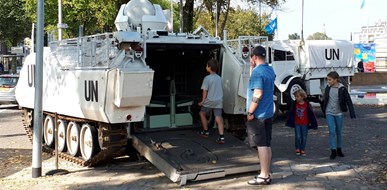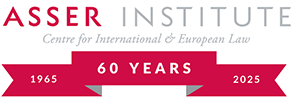Imagining Justice: visiting physical sites of international law
Published 13 May 2020
Photo taken by Asser researcher Dr Sofia Stolk
As part of the imagining justice research project, Dr Sofia Stolk has co-published three articles in the past months that emphasise the importance of international law’s physical sites. In the current times of self-isolation and staying home, ‘imagining justice’ gains new meanings, and we are more than ever depending on our imagination to visit such spaces and to bridge physical distances.
The three publications take you on a virtual tour through the buildings and public spaces where international law is practiced, visited, shaped and challenged. Together, they showcase that international law’s concrete visual form matters to international law’s existence and tangibility; enabling us to actually see and touch it. These publications invite you to do just that, even if from a distance.
International legal sightseeing
In their co-authored publication ‘International Legal Sightseeing’ published in the Leiden Journal of International Law, Sofia and Renske Vos, researcher and lecturer at VU Amsterdam, set the agenda for the Legal Sightseeing project that they coordinate together. They describe four examples of legal sightseeing sites and practices: the UN Headquarters’ Visitor Centre in New York; the Just Peace festival in The Hague; the Memorium Nuremberg Trials Nuremberg Palace of Justice; and the exhibition ‘Hybrid Peace’ in art centre Stroom, curated by Vasyl Cherepanyn. They primarily ask: ‘what is international law doing here?’, a question driven by both astonishment (what is it doing here?!) and curiosity (what is it actually doing here). The piece discusses that these interaction between people, mostly tourist, international law is spectacular and mundane at the same time: international law as a tourist attraction simultaneously makes it into a trivial practice for ‘ordinary’ people and elevates it into a celebratory event. In their piece, Sofia and Renske invite us to look for international law in unexpected shapes and places and to start thinking about how such manifestations of international law affect what it is, how it speaks to its international audiences and how it is perceived.
The architecture of institutional buildings
In another co-authored piece entitled ‘Law in Concrete: institutional architecture in Brussels and The Hague’, published in the Law and Humanity Journal, Sofia and Renske take the reader on a tour through two main sites of international law: the EU district in Brussels and the International Criminal Court (ICC) premises in The Hague. One of the most concrete encounters one can have with international law is to visit its institutional buildings. This piece discusses how institutional architecture is more than just a functional space. In a way, the façades of institutional buildings can function as the institution’s business card, communicating ideals and values and inviting or discouraging the engagement between the institution and its variety of visitors. As such, these buildings are part of what shapes international law’s imaginaries.
The Peace Palace as a home
Together with Tanja Aalberts, professor of Professor of Law and Security at VU Amsterdam, Sofia writes about ‘The Peace Palace: Building (of) The International Community’ in an online AJIL Unbound symposium. In this essay, Tanja and Sofia argue that the Peace Palace in The Hague provides a material home for the international community and, as such, contributes to the making of this very community. They discuss the importance of the building as well as the gifts that it received from participating states in visualising, imagining and enacting the international community. A community that is marked by at least two paradoxes: 1) the unity aspired by the states contrasts the individuality that is eagerly expressed in their gifts and 2) the aim of universality is challenged by the selective imagery and visual absence of certain states in the building.
Sofia believes there is a need for a creative, intuitive and reflexive approach to international law as a phenomenon that is broader than its texts, rules and procedures. “They allow for a second look and a more thoughtful reflection on the importance of the visual, the tangible and the absent of international law in the usual as well as unexpected places,” she says.
About the Legal Sightseeing project
Legal Sightseeing is a research platform initiated by Asser researcher Dr Sofia Stolk and Renske Vos, researcher and lecturer at VU Amsterdam. It includes a photo blog, academic research on the legal sightseeing phenomenon and an expanding legal sightseeing methodology. Sofia Stolk is involved in the research as part of her work for Asser's imagining justice project. Legal Sightseeing is co-hosted by the Centre for the Politics of Transnational Law.
About the Imagining Justice project
The imagining justice project looks at the manifestation of international law beyond the conventional focus on rules, regulations and court cases. It explores how different audiences understand, experience and evaluate international law through its visual presence e.g. in artworks, on social media, in films and through the symbolic architecture of its institutional buildings. Asser researcher and project leader Sofia Stolk says: “To imagine international justice is to think about its possible meanings, to conceptualise its possible forms and to reflect on international law’s opportunities, challenges and possible alternatives. The project rests on the idea that a change of perspective can provide us with new insights. An interaction between art and law can excite, harmonise, destabilise and estrange. It can also shed a different light on complicated concepts such as humanity, dignity, trust and justice. These concepts have interested jurists and artists alike.”
Further readings
- Sofia Stolk and Renske Vos (eds) 'Brutal International Law', special section in New Perspectives 28(1), 2020.
- Sofia Stolk and Renske Vos, 'International Legal Sightseeing', Journal of the Oxford Centre for Socio-Legal Studies issue 2, 2018.
Dr Sofia Stolk is a researcher in the Dispute Settlement and Adjudication strand at the T.M.C. Asser Instituut. This research strand is organised around inquiry into attributes of trustworthy dispute settlement in international adjudication.
